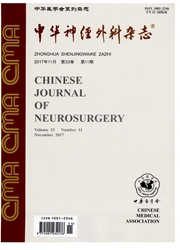

 中文摘要:
中文摘要:
目的分析海马细胞外氨基酸递质在癫痫发生中的作用,探讨海人酸致痫模型大鼠癫痫发生的机制。方法应用立体定向方法建立海人酸大鼠颞叶癫痫模型,观察大鼠行为学和电生理变化,应用电镜观察大鼠海马超微结构,应用微透析获取大鼠海马细胞外液,高压液相色谱法测定透析液中的兴奋性氨基酸谷氨酸、抑制性氨基酸牛磺酸及γ-氨基丁酸的含量。结果海人酸注射后大鼠出现典型的颞叶癫痫发作,皮层脑电显示痫性发作,电镜显示兴奋性神经递质增加,高效液相色谱分析显示海马细胞外谷氨酸、牛磺酸和γ-氨基丁酸含量明显高于对照组(P〈0.05),虽然谷氨酸、γ-氨基丁酸都升高,而谷氨酸升高的更明显。结论兴奋性氨基酸与抑制性氨基酸的失衡在海人酸致痫大鼠模型的癫痫发生过程中发挥重要作用,是癫痫发生的原因之一。
 英文摘要:
英文摘要:
Objective To establish and evaluate the animal model for temporal lobe epilepsy kindled by kainic acid (KA)in rats, to observe the changes in glutamic amino acid (Glu), tanrine amino acid (Tau) , and γ- -aminobatyric amino acid (GABA) of the extracellular fluid in the hippocampus of kindled rats, and to analyze the role of neurotransmitters in epileptogenesis. Methods In order to establish an animal model for temporal lobe epilepsy in rats, the characteristics of praxiological changes, electrophysiological changes, and ultrastructural examinations were observed. The contents of Glu, Tau, and GABA were detected in the hypppocampus by microdialysis combined with high performance liquid chromatography (HPLC). Results Typical seizures were observed in the models. Epileptic discharges, such as spike, slow, spike-slow, and sharp waves appeared in the electroencephalogram (EEG). Electron microscopic analysis of the hippocampal tissues revealed an increase of excitatory amino acid levels. The levels of Glu, Tau, and GABA were higher than groups that were injected with normal sodium ( P 〈 0. 05 ). Conclusion Excitatory amino acids and inhibitory amino acids in the presence of epilepsy play important roles and is one of the main causes of seizure.
 同期刊论文项目
同期刊论文项目
 同项目期刊论文
同项目期刊论文
 Essential tremor: treatment with deep brain stimulation of the ventral intermediate nucleus of the t
Essential tremor: treatment with deep brain stimulation of the ventral intermediate nucleus of the t Using electroacupuncture at acupoints to predict the efficacy of hippocampal high-frequency electric
Using electroacupuncture at acupoints to predict the efficacy of hippocampal high-frequency electric Neuroprotective effects of electrical stimulation of the anterior nucleus of the thalamus for hippoc
Neuroprotective effects of electrical stimulation of the anterior nucleus of the thalamus for hippoc A Macaque Model of Mesial Temporal Lobe Epilepsy Induced by Unilateral Intrahippocampal Injection of
A Macaque Model of Mesial Temporal Lobe Epilepsy Induced by Unilateral Intrahippocampal Injection of 期刊信息
期刊信息
